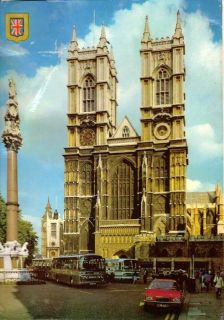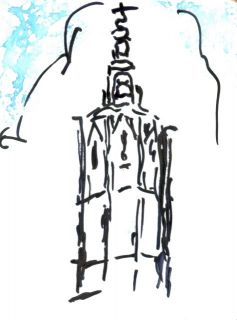

| Bells |
History It is probable that the Abbey built by Edward the Confessor, dedicated in 1065, and which had a central tower and two western towers was furnished with bells. The first recorded information concerning Abbey bells, however, is found in the Close Rolls of King Henry III where an instruction in 1230 to Edward of Westminster required that he make for the Abbey a bigger bell than any of those he had made previously. In the following year Edward was commissioned to make a small bell "that shall be in tune with the great bell". The chronicler Matthew Paris in 1255 noted that five bells were in use, and this was depicted in his illuminated manuscript. A bell cast for the Abbey c.1310 by Richard de Wimbis (Wymbish) bearing the inscription "Christe Audi Nos" still exists and will be on display in the new Jubilee galleries at the Abbey (due to open in 2018). By the late fifteenth century a ring of six bells was installed and although recasting occurred the number of bells at the Abbey remained at six until the twentieth century. In 1919 King George V and Queen Mary were present at London's Whitechapel Bell Foundry when two Abbey bells were recast and two bells newly cast to form a ring of eight. Restoration of the Abbey's bell installation had become necessary when ringing for the Armistice in 1918 was almost impossible due to the poor condition of the bell frame and fittings. The eight bells continued in use for 52 years ringing out in 1937 for the coronation of King George VI, in 1953 for the coronation of Queen Elizabeth II and on 8 May 1945 for VE Day (MP3)The weight of the tenor, the largest bell, was 28 cwt .[hundredweight] (1,410kg). In 1971 a bequest to the Abbey by Dr Eric Perkins, the brother of the Reverend Jocelyn Perkins who was Sacrist at the Abbey from 1900 to 1958, enabled a ring of ten bells to be cast. The Whitechapel Bell Foundry again was instructed. From the ring of eight the two oldest bells, which dated from the sixteenth century and the reign of Queen Elizabeth I, were retained. They are chimed (MP3) daily prior to evening service. Clochard In the mid thirteenth century (1249-53) under the aegis of King Henry III rebuilding the Abbey in the Gothic style commenced. At this time a separate bell tower or campanile was erected on the north side of the Abbey and bells rang out from this for 300 years. The remains of this structure were demolished in 1750. It was about 75 feet square and about 60 feet high.(This site is where the present Supreme Court stands) North West Tower During the sixteenth century six bells were installed in the incomplete north-west tower, the height of which was lower than the nave roof. In the early eighteenth century Sir Christopher Wren proposed the completion of the towers and the work was later undertaken by the Surveyor Nicholas Hawksmoor and his successor John James. At last in 1745, five centuries after the building of King Henry III's Abbey commenced, the colossal task was completed. The two towers were raised to their present height and the bells moved to a higher belfry in the north-west tower. Ten bells The 1971 ring of ten bells was dedicated at a service in the Abbey attended by Her Majesty Queen Elizabeth II on 9 November that year. The tenor bell has a diameter of 4 feet 6 inches (137 cm), a weight of 30 cwt 1 qtr. 15lb (1,530 kg) and is tuned to the note of D. Its inscription notes previous Abbey tenor bell castings in 1430, 1599 and 1738. The treble, the smallest bell, has a diameter of 2 feet 3 inches (618 cm) and a weight of 4cwt 3qtr 16lb (246kg). The inscriptions on each bell record its dedication and date of casting. The tenor bell is tolled (MP3) following the announcement of the death of a member of the Royal family and on the death of the Dean of Westminster. The bells are hung for traditional English style change ringing in which the bells swing full circle, allowing the ringers to vary the sequence in which the bells sound. The sequences are determined by rules that produce bell ringing methods, one of which rung at the Abbey is Yorkshire Surprise Royal. (WESTMINSTER ABBEY WEBSITE) |
|---|---|
| Traditional bell ringing |
Ringers The Abbey's Domesday cartulary records the establishment of the Brethren of the Guild of Westminster in 1255 whose members were charged with the duty of ringing the bells for an annual fee of one hundred shillings. In 1921 Dean Ryle, following what he believed to have been the spirit of the old Brethren, organised the Westminster Abbey Company of Ringers. This is a volunteer group which continues to operate and which comprises principal, supernumerary and honorary members. Ringing occasions The Abbey bells are rung for major church festivals, saints' days, Royal and Abbey anniversaries, civic events and for special services. Service ringing takes place at service conclusion except when the Monarch attends when the bells are also rung beforehand. On solemn occasions the bells are rung half-muffled, a leather pad being strapped to one side of the clapper ball. The bells provide a distinctive effect sounding strident and soft alternately. Ringing for All Souls and Remembrance is half-muffled and the method Stedman Caters (MP3)is rung. Peals Significant events and anniversaries whether royal, national or Abbey related are marked by the ringing of a full peal. This comprises a minimum of 5000 different changes (or sequences) and is performed without a break. A peal takes over three hours to complete and demands considerable concentration by the ringers and the conductor all of whom commit the progress of the 5000 changes to memory. Inscribed peal boards noting the event, the ringers and other information are mounted on the ringing chamber walls. Sister rings Two other rings of bells have been cast to the same specification as those at the Abbey. In 1936 the Whitechapel Bell Foundry reproduced the sizes and weights of the then eight Abbey bells for Christ Church Cathedral, Victoria, British Columbia, Canada. In 1977 a set of bells, cast by Whitechapel to the specification of the Abbey's ten bells, formed a bicentennial gift by the English Ditchley Foundation to the Congress of the United States. The bells are installed in the Old Post Office Tower in Washington D.C. and each bell is inscribed with the Great Seals of the United States and of Britannia. The Abbey's coat of arms is cast on the headstock of each bell. |
| Current bell ringing | Change Ringing Method, with 10 bells. |
| Author | |
Bibliography (Can be sort by any of the fields)
| Author | Title | Date |
|---|---|---|
| ANÓNIMO | Dice un periódico | 1875 |
| MURRAY, Sarah | Las ideas nuevas que aportan los herederos a las empresas familiares | 2016 |
| AFP | Campanas sonaron por los 70 años de matrimonio de la reina Isabel II de Inglaterra y Felipe de Edimburgo | 2017 |
| WESTMINSTER ABBEY | Abbey bells | 2017 |
| RODRÍGUEZ, A. | Las campanas sonarán por el príncipe Andrés (a pesar de todo) | 2020 |
Sound records (Can be sort by any of the fields)
| Person | Audio | Date | Duration |
|---|---|---|---|
| WESTMINSTER ABBEY COMPANY OF RINGERS | VE Day Bell Ringing | 08-05-1945 | 00:30 |
| Medieval Bells Chimed | 2017 | 00:15 | |
| Tenor Bell | 2017 | 00:15 | |
| WESTMINSTER ABBEY COMPANY OF RINGERS | Yorkshire Surprise Royal | 2017 | 02:27 |
| WESTMINSTER ABBEY COMPANY OF RINGERS | Stedman Caters | 2017 | 02:40 |
Video (Can be sort by any of the fields)
| Person | Video | Date | Duration |
|---|---|---|---|
| WESTMINSTER ABBEY COMPANY OF RINGERS | Westminster Abbey Bell Ringers | 03-05-2007 | 02-11 |
| THE CENTRAL COUNCIL OF CHURCH BELL RINGERS (CCCBR) | The bell tolls for tradition | 01-01-2017 | 01:31 |
| DEVON ASSOCIATION OF RINGERS | The bells of Westminster Abbey, London | 01-01-2017 | 17:22 |
| WESTMINSTER ABBEY COMPANY OF RINGERS | Prince Philip: Westminster Abbey bells ring once every 99 minutes in tribute | 09-04-2021 | 01:01 |
